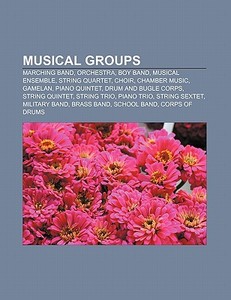
Musical groups
Marching band, Orchestra, Boy band, Musical ensemble, String quartet, Choir, Chamber music, Gamelan, Piano quintet, Drum and bugle corps, String quint
- Editore:
Books LLC, Reference Series
- EAN:
9781157410379
- ISBN:
1157410375
- Pagine:
- 132
- Formato:
- Paperback
- Lingua:
- Inglese
Descrizione Musical groups
Source: Wikipedia. Pages: 132. Chapters: Marching band, Orchestra, Boy band, Musical ensemble, String quartet, Choir, Chamber music, Gamelan, Piano quintet, Drum and bugle corps, String quintet, String trio, Piano trio, String sextet, Military band, Brass band, School band, Corps of Drums, Concert band, Territory band, Girl group, Drum major, Show choir, Wind quintet, Tribute act, All-female band, Tuna, Drumline, Gamelan outside Indonesia, Indoor percussion ensemble, Conductorless orchestra, Octet, String orchestra, Cover band, Boys' choir, Community band, Lead vocalist, Piano quartet, Djent, DC3 Music Group, String section, Jazz trio, Glee club, Horn section, Men's chorus, Internet band, House band, Solo, Fanfare band, Piano sextet, Samba band, Fanfare orchestra, Eduardo and His Brazilian Aeroplane, Pickup group, Unsigned band, Spasm band, Takht, Power duo, Flute choir, Miles From Home, DJ big band, String octet, Urusen, List of musical ensemble formats, Junk band, Firqa, Studio band, Nòva cançon. Excerpt: Chamber music is a form of classical music, written for a small group of instruments which traditionally could be accommodated in a palace chamber. Most broadly, it includes any art music that is performed by a small number of performers with one performer to a part. The word "chamber" signifies that the music can be performed in a small room, often in a private salon with an intimate atmosphere. However, it usually does not include, by definition, solo instrument performances. Because of its intimate nature, chamber music has been described as "the music of friends." For more than 200 years, chamber music was played primarily by amateur musicians in their homes, and even today, when most chamber music performance has migrated from the home to the concert hall, there are still many musicians, amateur and professional, who continue to play chamber music for their own pleasure. Playing chamber music requires special skills, both musical and social, which are different from the skills required for playing solo or symphonic works. Johann Wolfgang von Goethe described chamber music (specifically, string quartet music) as "four rational people conversing." This conversational paradigm has been a thread woven through the history of chamber music composition from the end of the 18th century to the present. The analogy to conversation recurs in descriptions and analyses of chamber music compositions. From its earliest beginnings in the Medieval period to the present, chamber music has been a reflection of the changes in the technology and the society that produced it. Plato, Aristotle, Hippocrates and Galen play a quartet on viols in this fanciful woodcut from 1516.During the Middle Ages and the early Renaissance, instruments were used primarily as accompaniment for singers. String players would play along with the melody line sung by the singer. There were also purely instrumental ensembles, often of stringed precursors of the violin family, called consorts Some analysts co












